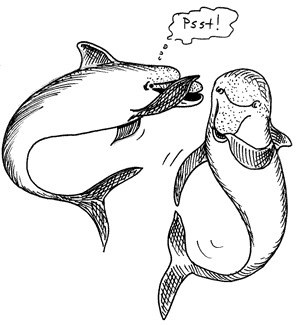STRANGE BUT TRUE- Fish dish: Dolphins talking trash

DRAWING BY DEBORAH DERR McCLINTOCK
Q. What's a most surprising thing dolphins do when they get together? People do it too, behind each other's back, as do magazines and TV shows– to the point where it may bring down a president or a prime minister. If you thought dolphins above this sort of behavior, think again. So what are the Flippers of the world up to? –J. Cousteau
A. They gossip, reports a team of Scottish marine biologists. Amazingly, each bottlenose dolphin identifies itself with a unique series of clicks and whistles along the lines of Woo-woo-wee-wee or even Woo-woo-wee-woo-wee-woo, says Bruno Maddox in Discover. This has long been known, but what the researchers uncovered is that two clicking and whistling bottlenecks will at times use the name of a third dolphin when it is not present. "For those of us who've been led to believe dolphins are a higher order of being– honorable and enlightened, Gandhis with blowholes–their gossiping came as something of a blow to the stomach."
Q. Why does your urine stink when you eat asparagus? If it does! Maybe we'd better ask your nationality first. –J. Child
A. It's due to a sulfur compound called mercaptan, also in onions, garlic, rotten eggs, say Mark Leyner and Billy Goldberg in Why Do Men Have Nipples? The signature smell occurs when the compound is broken down in the digestive system. But not all people have the gene for the enzyme that does this, so some won't unloose the malador. The British Journal of Clinical Pharmacology notes that while 100 percent of French people tested had the gene, only 46 percent of British people did; so it's far from an equal olfactory opportunity vegetable.
Q. That annoying co-ed next to you in science class keeps cracking her knuckles, until she's knuckled out. For an "A" in anatomy, what's behind the cracking sounds, and why the periodic respites? –J. Hingeley
A. Pull on a finger with enough force and the knuckle cavity (space between bones) widens, reducing the pressure on the synovial fluid inside, says Jearl Walker in The Flying Circus of Physics. Now gas bubbles may suddenly form, primarily carbon dioxide, that had been dissolved in the fluid. This "cavitation" sends a pressure pulse through the fluid, the knuckle cavity, and out into the air. End of show– for now. It will take 15-30 minutes for the cavity to recover its initial shape, as the fluid is squeezed back to a thin layer between the bones and the gas redissolved into the fluid. "Until then, she will need some other bad habit to annoy the people around her," Walker notes.
Q. That microphone hidden in a shrub along the roadway– what's it doing there? Clue: Think Fuzzbuster-buster. –J. Bond
A. Police may use it to gauge the "Doppler shift" (change in pitch) of your car's noise as you drive by, says New Scientist magazine. The ace in this speed-enforcement game is that– unlike radar or laser-based devices– the system emits no telltale radiation and so cannot be picked up by dashboard detectors. When University of Tennessee researchers tested this, they could determine speeds to within a few percent in 32 of 33 experiments.
Plus, the engine's pulsing sound gives away the rotations per minute, an acoustic tipoff to approximate engine size. With microphones installed along calibrated roadway slopes, police can monitor a truck's increased power expenditure, allowing calculation of vehicle weight and whether the truck is overloaded. Some sound science in service of snoopability.
Send Strange questions to brothers Bill and Rich at [email protected].
#